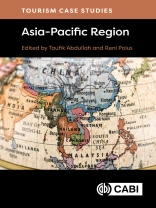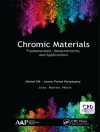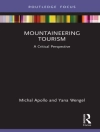Tourism Case Studies from the Asia-Pacific Region offers a comprehensive exploration of the diverse world of tourism within one of the most dynamic regions on the globe. Authored by leading academic and industry experts, this volume fills a crucial gap in tourism literature by providing practical and engaging case studies that highlight real-world industry best practices, challenges, and opportunities.
The volume explores critical topics such as sustainable practices, cultural preservation, community empowerment, resilience, management strategies, policy development, and emerging trends. With 32 case studies, readers are taken on a journey through the unique characteristics of tourism destinations in the Asia-Pacific region, from the bustling cities of China and Japan to the emerging markets of India and beyond. Each case study provides clear aims, context, and outcomes, offering invaluable insights and practical lessons that can be applied in various tourism contexts.
Designed for both academic and professional audiences, this volume serves as an essential resource for instructors looking to enhance their teaching practices, students aspiring to succeed in the tourism industry, and practitioners seeking to understand the complexities and opportunities within the Asia-Pacific tourism landscape.
قائمة المحتويات
Section 1: Environmental sustainable practices for tourism
Chapter 1 – Sustainable Hiking through the Green Trails: Examples of Exceptional Responsible Practices
Chapter 2 – Sustainable Tourism and Stakeholders’ Satisfaction in Batulayang Tourism Village Bogor Indonesia
Chapter 3 – Adopting Sustainable Practices at an Island Ecotourism Destination in Sabah through a Sea Turtle Conservation Project
Chapter 4 – Overtourism and Tourism Sustainable Management in the Komodo National Park, Indonesia
Section 2: Cultural preservation and identity through tourism
Chapter 5 – Improving Cultural Sustainable Tourism: Evidence of Saba Budaya Baduy from Baduy Tribe, Indonesia
Chapter 6 – Hawker Centres, Cultural Heritage and Tourism – A Case Study of Lau Pa Sat, Singapore
Chapter 7 – Experiencing Cambodia’s Living Arts through Tourism
Chapter 8 – Aikido Tourism Development in Tanabe, Wakayama, Japan
Chapter 9 – Forging Social Identity: The Making of a Destination – A Case of the Bullet Baba Shrine in Marwar, Rajasthan, India
Section 3: Empowerment through tourism
Chapter 10 – Community-Based Ecotourism and Conservation in Tboli, Philippines
Chapter 11 – Business Strategy and Development toward Sustainability: A Story of Ban Bo Chet Luk Community Entrepreneurship, Thailand
Chapter 12 – The Guesthouse Phenomenon in the Maldives – Development and Issues
Chapter 13 – Breaking Barriers, Building Futures: The Transformative Power of Tourism in Empowering Women in Munsiyari, India
Section 4: Resilience and recovery through tourism
Chapter 15 – Green Recovery and Regenerative Tourism: The Success Story of Miso Walai Homestay in Building a Resilient Rural Tourism Destination
Chapter 16 – The Bojo Algouinsan Ecotourism Initiative: Crisis Mitigation Through Community Tourism Development
Chapter 17 – The Realities of Peripheral Handicraft Livelihoods in the Face of Disasters in Vanuatu
Chapter 18 – Resilience and Loyalty in the Face of Adversity: A Case of Local Employees in Kerala’s Backwater Tourism
Chapter 19 – Responses from Businesses in Rural Communities Recovering from the 2011 Tohoku Disasters during the 2020 Tokyo Olympics
Chapter 20 – ‘Not All Fun and Games’: The Case of the Victoria 2026 Commonwealth Games
Section 5: Critical studies in tourism
Chapter 20 – The Growth of Tourism and ‘Development’ in an Indigenous Setting: Exploring a Case of the Chittagong Hill Tracts, Bangladesh
Chapter 21 – Haunting Memory of Forgotten History: A Case Study of WWII ‘Comfort Stations’ in the Philippines as a Tourism Resource Featured in Selected Filipino Films
Chapter 22 – Elephant-Based Tourism in Nepal: The Key to Reducing Human Poverty or a Tool to Commodify Endangered Species?
Chapter 23 – ‘We Invite You for Lunch’: Post/Colonial Subjectivities and Performances of Tourism in Puducherry, India
Section 6: Emerging trends in tourism
Chapter 24 – Surfing in Hainan Island: An Emerging Surfing Tourism Destination in China
Chapter 25 – Learning by Doing: Educational Tourism at Mount Danxiashan
عن المؤلف
Dr. Szydlowski’s previous research focused on how ecotourism practices impact community-based conservation efforts for rhino and elephant. She spent the last seven years teaching avian and reptile medicine, behavior, anthrozoology, sheltering, and conservation in US colleges. Szydlowski works with community-based conservation efforts focused on endangered species preservation, wildlife health, and sustainable development in Nepal. She continues to study governmental and I/NGO programs which purport to help captive elephants, and how their interactions impact population-level health and individual elephant lives. Her research also focuses on the welfare of endangered elephants and the members of marginalized communities that care for them. She is now working with several elephant owners and interest groups to create lasting, positive welfare changes for elephants in Nepal.
Dr. Szydlowski previously served as the board chair for a global conservation fund. She now serves on the advisory board of an elephant-focused NGO. She is active in environmental and humane education projects, one world/one health programs, and biodiversity preservation. When not teaching, she can be found speaking about her work in Nepal, conservation, neurodiversity, anthrozoology, etc. Upcoming projects include a human-elephant conflict mitigation program and a companion animal study with co-researchers from four countries. Michelle co-hosts The Anthrozoology Podcast, which discusses complex species relationships. You can visit her at internationalelephants.org.












